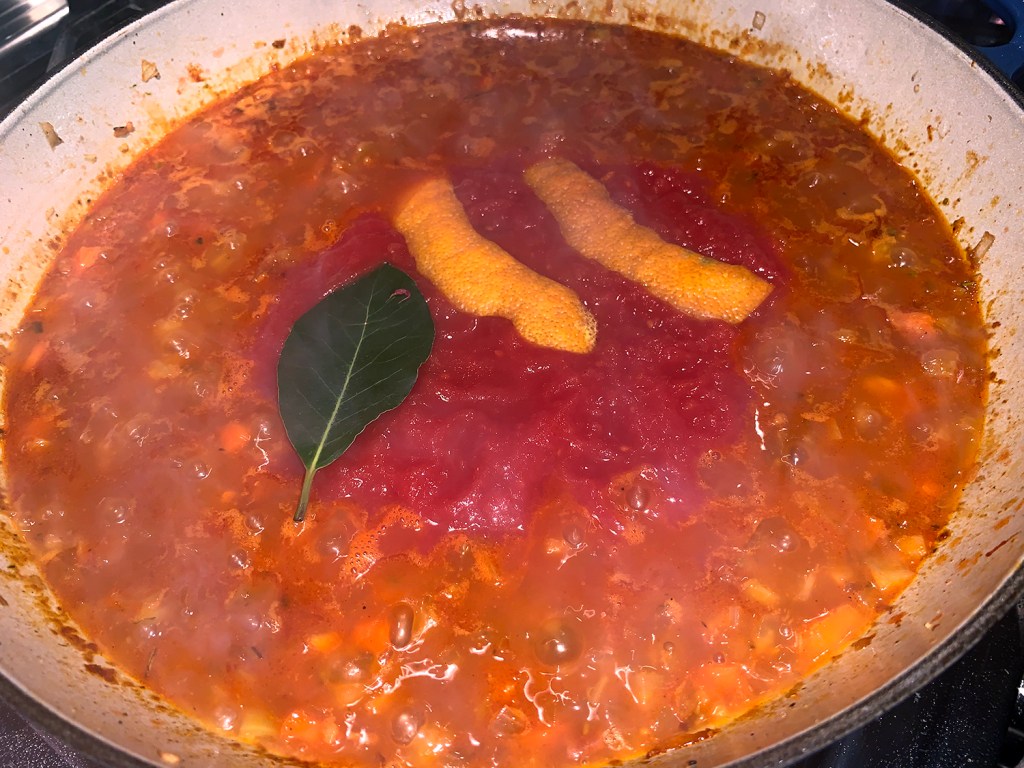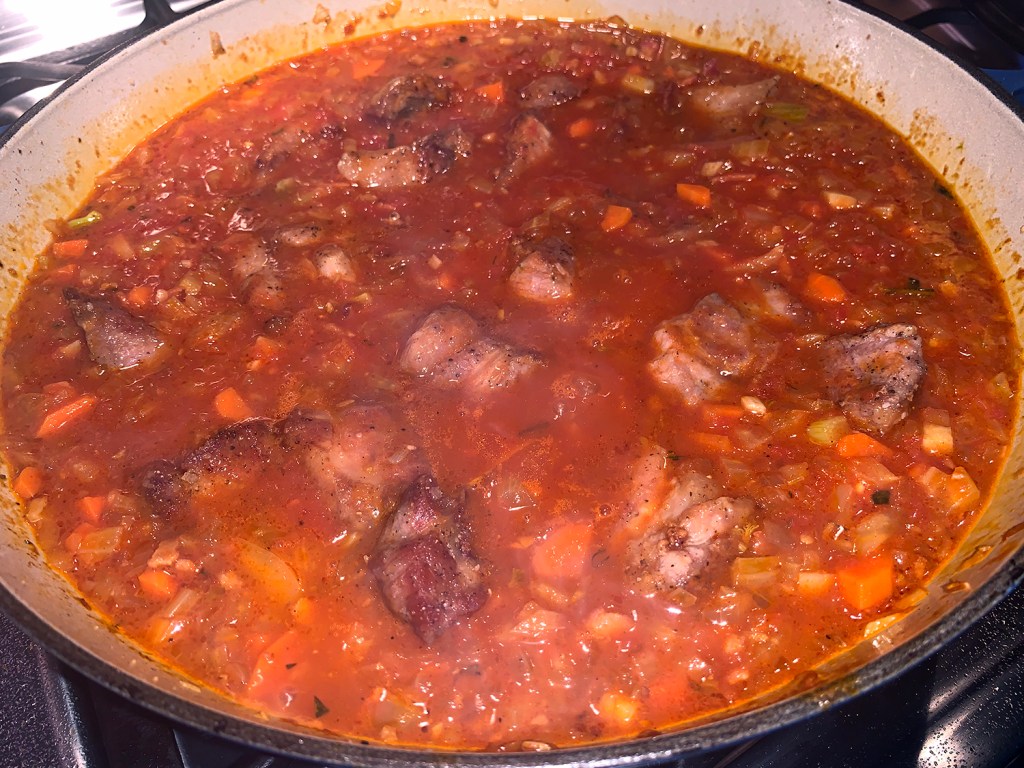Just so we’re all clear, ragoût is a French word for stew. However there is nothing terribly French about this dish. The recipe hails from Molly Stevens‘ latest cookbook “All About Dinner” where she explains the title comes from the verb ragoûter which means “to perk up, to revive the taste of,” and that’s exactly what the hard cider does here.
We were lucky enough to have a growler of son Dan’s homemade hard cider that he gifted us over the holidays. The sharp, lightly appley taste brings out the porks natural sweetness and balances the acidity of the tomatoes. The depth of flavor overall was astounding!

While it was fabulous from the get-go, like most stews and braises, this tastes even better a day or three later. That fact makes it a good choice for company, because you can make it a day or two ahead and then just gently reheat the ragoût while making the polenta. Yes, we did have leftovers, and were loving them a few days later…

Cider-Braised Pork Ragoût
Ingredients
- 1 1/2 lbs. boneless pork shoulder, trimmed and cut into 2″ chunks
- 2 Tbsp. extra-virgin olive oil
- Salt and freshly ground black pepper
- 1 oz. pancetta or bacon, finely chopped
- 1 med. yellow onion, finely chopped
- 1 med. carrot, finely chopped
- 1 small fennel bulb, trimmed and finely chopped
- 2 garlic cloves, minced
- 1 tsp. finely chopped rosemary
- 1 tsp. fennel seeds, toasted and lightly crushed
- 1/2 tsp. coriander seeds, toasted and lightly crushed
- 1 heaping Tbsp. tomato paste
- 2 cups hard cider, preferably dry
- 1 14-oz. can tomato puree or crushed tomatoes
- 1 ay leaf
- 2 strips orange zest, removed with a vegetable peeler (about 3 ” x 3/4″)
- 2-3 Tbsp. chopped fresh parsley
Directions
- Arrange the pork chunks on a tray and pat dry. Heat a heavy-bottomed Dutch oven (4-6 quarts) over medium heat, then add the oil.
- While the oil heats, sprinkle salt and pepper on half of the pork (you will season in two batches and prevent the meat from sweating as it sits). When the oil is hot, add the seasoned chunks without crowding the pan.
- Cook, turning the pieces with tongs, until nicely browned all over, 12 to 15 minutes per batch. Transfer the browned pork to a plate and repeat with remaining pork.
- Examine the empty pot and discard all but two tablespoons of fat, if necessary. Wipe out any black areas, but leave the meaty drippings and browned bits.
- Once all the pork is browned, return the pot to medium heat and add the pancetta/bacon and cook, stirring once or twice with a wooden spoon. until it begins to soften, about 2 minutes.
- Add the onion, carrot, fennel, garlic, rosemary, coriander and fennel seeds, season with salt and pepper, and cook, stirring occasionally, until the vegetables begin to soften, about 5 minutes.
- Stir in the tomato paste, working it through the veggies so it is evenly distributed. Let cook for 1 minute, then add 1/2 the cider.
- Increase the heat to medium-high, scrape the bottom of the pot with the wooden spoon to dislodge and dissolve all browned bits, and cook at a rapid simmer until the cider is reduced by about two-thirds, about 8 minutes.
- Add the remaining cider, return to a simmer, stir and cook for another 2 minutes.
- Add the tomato puree, bay leaf and orange zest strips, and bring back to a simmer.
- Return the pork to the pot, lower the heat so the liquid barely simmers, and cover. Cook gently to maintain a quiet simmer with bubbles slowly rising to the surface, stirring occasionally to ensure that nothing is sticking, until the pork is fork-tender, about 1 1/2 to 2 hours.
- Meanwhile, make the Creamy Polenta as per the recipe below.
Creamy Polenta

According to Molly, the difference between mediocre polenta and superb polenta is starting with stone-ground cornmeal and allowing plenty of time for it to cook—45 to 60 minutes. The extended simmer allows the grains to swell into a soft, fluffy porridge redolent of corn flavor. Made with part milk instead of all water, it creates a softer, creamier porridge.
Creamy Polenta
Ingredients
- 5 cups liquid, half water, half milk
- Salt
- 1 cup polenta (cornmeal) preferably stone-ground
- 1 to 4 Tbsp. butter
- 1 to 2 oz. Parmesan, grated
- Freshly ground black pepper
Directions
- Heat 4 cups of the mixed liquid (milk and water) in a heavy-bottomed 3- to 4-quart pot over medium-high heat until just warm. Add a good pinch of salt, then add the polenta in a steady stream, whisking to avoid lumps, and let come to a gentle boil.
- Reduce the heat to medium-low to maintain a gentle simmer as you whisk occasionally. Once the mixture begins to thicken, switch to a wooden spoon and stir regularly—once every few minutes at first, less frequently as the polenta gets thicker, scraping the bottom as you go, and continue to adjust the heat as needed so that the occasional fat bubble breaks the surface but the polenta does not boil and splatter like hot lava.
- Add the remaining one cup liquid (milk and water) in 1/4 cup increments as need to keep the polenta smooth and creamy. (I used only a 1/2 cup total in this instance.) Continue to to simmer and stir, until the polenta is fluffy and tender, about 45 to 60 minutes total.
- Stir in the butter and parmesan and season with salt and pepper to taste.
- Serve in shallow bowls and ladle the pork ragoût over the polenta. Garnish with chopped parsley.
Both recipes come from Molly Stevens “All About Dinner” cookbook







